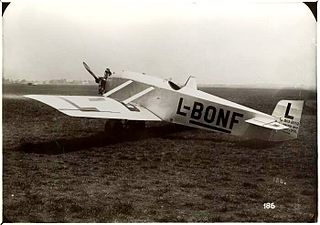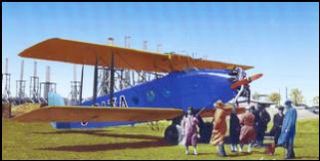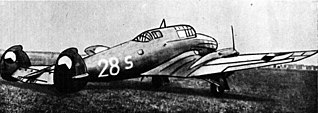
The Aero Letňany A.10 was a biplane airliner produced in Czechoslovakia shortly after World War I. It was the first commercial aircraft to be built in Czechoslovakia and was known as the Ae-10 Limousine. It was designed by Husnik and Vlasak and was intended to meet the growing need for aerial communication to and from the country. Behind the single nose-mounted engine was a cabin with seats for three and two tables, upholstered on the underside, and able to be inverted to provide another two seats if required. A double skinned firewall between the engine and cabin, together with double skinned surfaces to the walls, floor and roof and Triplex windows gave a (relatively) quiet ride. A rear window gave communication with the pilot, whose open cockpit was above and behind the cabin. The cockpit also accommodated the navigator who had a seat directly behind the pilot.

The Aero A.300 was a Czechoslovak bomber aircraft that first flew in 1938 as a much refined development of the A.304. It was designed by Aero to meet a requirement for a bomber-reconnaissance aircraft for the Czechoslovak Air Force, the Aero A-304 transport/bomber formed the basis for its design. It was a four-seat aircraft powered by two Bristol Mercury IX radial engines. The A-300 was faster than any other Czechoslovak aircraft in the inventory except for the Avia B-35 fighter. Despite showing much promise, development and production of the aircraft was stopped by the German occupation of Czechoslovakia.

The Aero L-60 Brigadýr was a small, high-wing propeller-driven Czechoslovakian STOL utility aircraft developed for both civil and military use. A prototype, designated XL-60, with Argus As 10C engine, first flew on December 24, 1953, but it was not successful. The plane was thoroughly redesigned and the second improved prototype, with M-208B flat-six engine, flew on June 8, 1954. The aircraft's configuration bears a strong resemblance to the Fieseler Fi 156 "Storch" licence-produced in Czechoslovakia during and after World War II, and which this aircraft was intended to replace. By the end of production in 1960, 273 had been built by Aero, including an improved version, the L-160 with an all-metal tail.

The Avia BH-1 was a two-seat sports plane built in Czechoslovakia in 1920. It was the first product of the Avia company, and it was originally designated BH-1 exp. The BH-1 was a low-wing braced monoplane of wooden construction, with tailskid undercarriage. Power was provided by a Daimler engine, which proved inadequate to fly the aircraft with both seats occupied.

The Avia BH-5 was a two-seat sport aircraft built in Czechoslovakia in 1923. It was based on the firm's experience with the BH-1 and shared that aircraft's basic design: a low-wing, braced monoplane. As a result of its L-BOSA registration, all slow flying Avia monoplanes of the BH-5 lineage were nicknamed Boska. The BH-5 was flown competitively by Zdeněk Lhota at the Belgian Touring Aircraft Contest in Brussels in 1923, and won both the overall prize for the event and the King of Belgium Prize. The same year, it won the first prize in its class in the Czechoslovak President of the Republic Competition.

The Avia BH-7 was a prototype fighter aircraft built in Czechoslovakia in 1923. It was a parasol-wing monoplane developed in tandem with, and as an alternative to the BH-6, which shared its fuselage and tail design. Like the BH-6, the BH-7 was involved in a number of serious crashes during its test programme, which led to its abandonment as a fighter. Undaunted, however, Avia used the design as the basis for a racing aircraft, shortening the wingspan by 1.4 m, fairing the wing directly onto the top of the fuselage and dispensing with the cabane struts. This revised version was designated BH-7B and the fighter (retrospectively) as the BH-7A. When the design proved no more successful as a racer, it was finally put to rest.

The Avia BH-9 was a twin-seat sports plane built in Czechoslovakia in 1923, based on the BH-5. As with other developments in the BH-1 lineage, the BH-9 was a low-wing braced monoplane that accommodated the pilot and passenger in tandem, open cockpits. The BH-9's structure was strengthened to allow the use of a higher-power engine than in its predecessors, and for the first time, this was a domestically produced powerplant. Although built as a twin-seat aircraft at least one was converted to a single-seater.

The Avia BH-10 was a single-seat aerobatic sports plane built in Czechoslovakia in 1924, based on the Avia BH-9, which was in turn developed from the BH-5 and BH-1. It was easily visually distinguished from the BH-9 by the tall anti-roll pylon added behind the open cockpit in order to protect the pilot in the event that the aircraft flipped over or crashed while inverted. 21 copies of the aircraft were built, 10 of which were bought by the Czechoslovakian Army as a training aircraft and operated under the designation B.10.

The Avia BH-11 was a two-seat monoplane sport aircraft designed and produced by the Czechoslovakian aircraft manufacturer Avia.

The Avia BH-19 was a fighter aircraft built in Czechoslovakia in 1924. It was a low-wing braced monoplane derived from the Avia BH-3 and reflected its designers' ongoing belief that the monoplane configuration was the most suitable for a fighter aircraft. Initial trials revealed excellent performance, but also displayed control problems and aileron flutter. Nevertheless, the Czechoslovakian Army was sufficiently impressed to inform Avia that it would order the BH-19 if the problems could be rectified. The first prototype was destroyed in a crash during speed trials, and the second prototype revealed no better handling than its predecessor. At this point, the Czechoslovakian War Ministry stepped in and asked Avia to cease its attempts to develop a monoplane fighter.

The Avia BH-22 was a trainer aircraft built in Czechoslovakia in 1925, based on the BH-21 fighter. A smaller engine was used and armament removed. The lighter engine required the wing stagger to be decreased. No significant modifications were made to the airframe structure, reduced weight further increasing the ultimate load factor. Some aeroplanes carried a camera gun. The type saw long service as a special aerobatic trainer and eventually several examples found their way into Czechoslovakia's aero clubs.

The Avia BH-25 was a biplane airliner built in Czechoslovakia in 1926.

The Avia BH-28 was a military reconnaissance biplane aircraft developed in Czechoslovakia in 1927 to meet a requirement for such an aircraft by the government of Romania. Avia based the design on their BH-26, but replaced the engine with an Armstrong Siddeley Jaguar, as specified in the requirement. The completed aircraft was taken to Bucharest for demonstration, but no order ensued, and this prototype was the only example constructed.

The Avia BH-29 was a trainer aircraft built in Czechoslovakia in 1927, in the hope of marketing it to both the Czechoslovakian Army, and to Czechoslovakian Airlines as a primary trainer. It was an conventional design, an unequal-span biplane of wooden construction and with tailskid undercarriage. The pilot and instructor sat in tandem open cockpits. A more powerful version was built, powered by a 120 hp (89 kW) Walter NZ-120 radial engine.

The Avia BH-33 was a biplane fighter aircraft built in Czechoslovakia in 1927. It was based on the BH-21J which demonstrated promising results by combining the original BH-21 airframe with a licence-built Bristol Jupiter radial engine. Other than the peculiar Avia hallmark of having an upper wing with a shorter span than the lower, it was utterly conventional, even featuring a tail fin for the first time in a Pavel Beneš and Miroslav Hajn design.

Praga E-39/BH-39 was a Czechoslovak trainer aircraft.
The Letov Š-32 was an airliner produced in small numbers in Czechoslovakia during the 1930s. It was a trimotor monoplane with a high, cantilever wing, and was designed to meet a requirement by ČSA for a machine to service a night route between Prague, Bratislava, Uzhorod, and Bucharest. It could carry up to six passengers in a fully enclosed cabin which was praised at the time as being "particularly roomy and lofty". The wings were of all-metal construction, and the fuselage was built up from steel tube and was mostly skinned in metal, other than its very rear part, which, like the empennage, was fabric-covered.

The Letov Š-39 was a sport aircraft produced in Czechoslovakia during the 1930s. It was a conventional, parasol-wing monoplane with fixed tailskid undercarriage, and seating for the pilot and passenger in tandem, open cockpits. Because the cabane struts were very short, and the wing therefore placed very close to the top of the fuselage, the cockpits had the unusual arrangement of the passenger's being in front of the wing while the pilot's was behind it. The outer half of each wing was fitted with fixed slats along the leading edge. An initial batch of 23 machines was built for use by Czech aeroclubs. These were followed by batches of aircraft with alternative powerplants.

The Avia B.158 was a prototype Czechoslovak twin-engined light bomber aircraft of the 1930s. Only a single example was built and it was abandoned, following the German occupation of Czechoslovakia in March 1939.

The Etrich Sport-Taube was a one-off, single engine, one seat monoplane, built in Czechoslovakia in 1929.




















